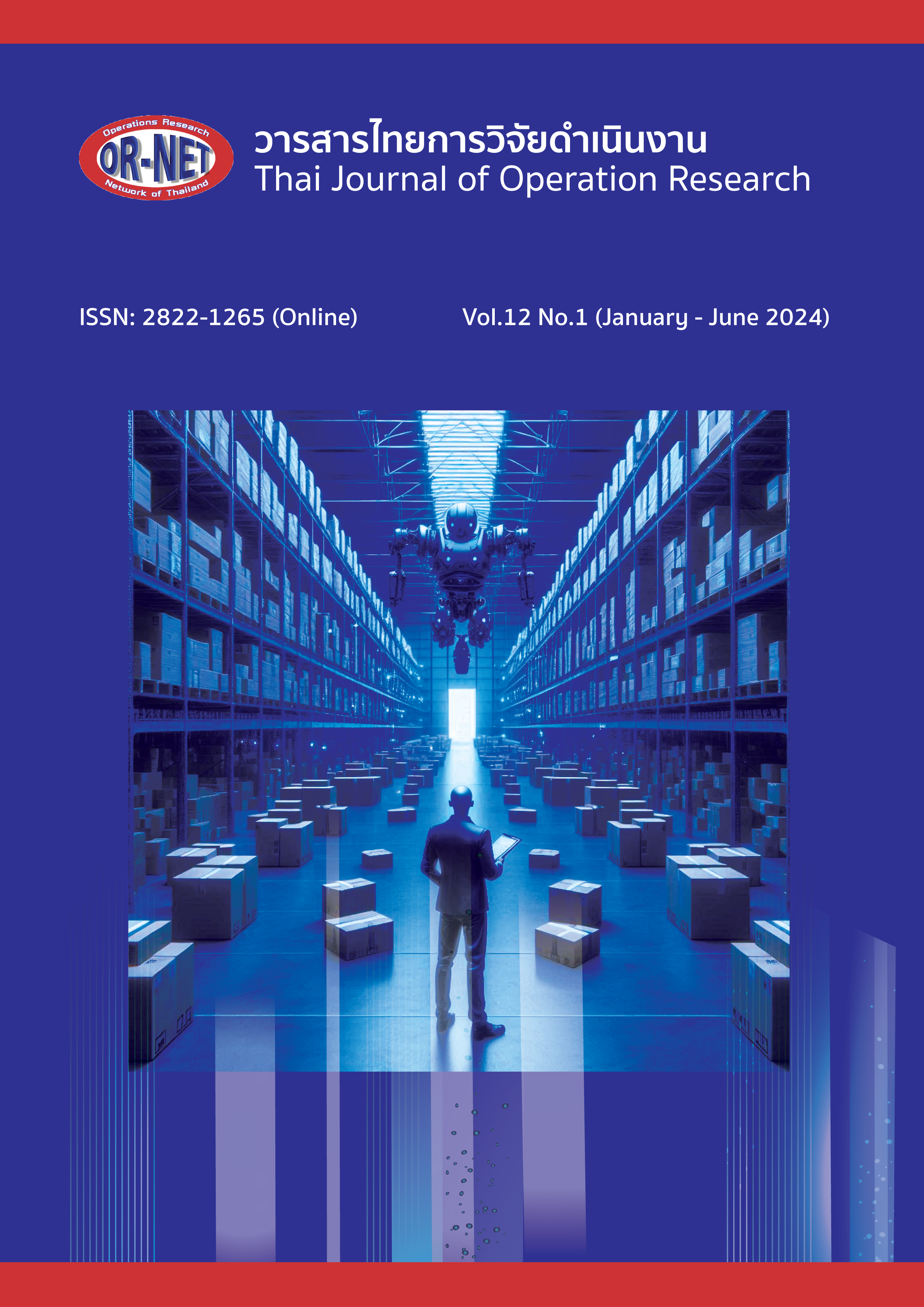Forecasting the Supply Chain Demand of Agricultural Residues for Biomass Power Plants Using Machine Learning
Keywords:
biomass, agricultural residues, forecasting, machine learningAbstract
This research investigated the supply chain of biomass derived from agricultural residues of five crop types in the Northern region of 17 provinces in Thailand, with the aim of evaluating the potential quantity of agricultural residues available for electricity generation through biomass. Historical data was utilized, and 5 machine learning models were employed to determine the optimal model for the dataset, which included 11 factors. The dataset was divided into 80% for training the models and 20% for testing. The Random Forest Regression model with n_neighbors = 1 emerged as the most effective for predicting production from this dataset, achieving a Mean Absolute Percentage Error (MAPE) of 27.511%. The results indicate that machine learning techniques can be utilized to forecast agricultural production effectively. This approach enables the estimation of agricultural residues from various crops, thus facilitating the calculation of biomass energy derived from agricultural residues for biomass power generation. The implications of these findings are substantial, as they demonstrate the potential of machine learning in the utilization of biomass resources for renewable energy production.
References
กรมพัฒนาพลังงานทดแทนและอนุรักษ์พลังงาน, คู่มือการพัฒนาและการลงทุนพลังงานชีวมวล, พิมพ์ครั้งที่ 1., กรุงเทพมหานคร: เอเบิล คอนซัลแดนท์, 2554.
กองนโยบายและแผนพัฒนาการเกษตร, ภาวะเศรษฐกิจทางการเกษตร ปี 2563 และแนวโน้มปี 2564, กรุงเทพมหานคร: สำนักงานเศรษฐกิจการเกษตร, 2563.
พุฒิชาติ คิดหาทอง, วีรินทร์ หวังจิรนิรันดร และ อัจฉริยา สุริยะวงค์, “การศึกษาศักยภาพเชิงพื้นที่ของชีวมวลสำหรับผลิตไฟฟ้าของประเทศไทย,” วารสารวิจัยพลังงาน., ปีที่ 11, ฉบับที่ 1, น. 63-76, 2557.
A. Kantasa-Ard, M. Nouiri, A. Bekrar, A. Ait el Cadi and Y. Sallez, “Machine learning for demand forecasting in the physical internet: a case study of agricultural products in Thailand,” International Journal of Production Research., vol. 59, no. 24, pp. 7491-7515, 2020.
กรมพัฒนาพลังงานทดแทนและอนุรักษ์พลังงาน, คู่มือการพัฒนาและการลงทุนพลังงานชีวมวล, พิมพ์ครั้งที่ 1., กรุงเทพมหานคร: เอเบิล คอนซัลแดนท์, 2554.
B. Dangprok, K. Y. Tippayawong and N. Tippayawong, “Development of a cost optimization model for power generation from agricultural residual biomass in Thailand,” Energy Reports., vol. 9, pp. 55-62, 2023.
A. Welfle, P. Gilbert and P. Thornley, “Increasing biomass resource availability through supply chain analysis,” Biomass and Bioenergy., vol. 70, pp. 249-266, 2014.
E. Iakovou, A. Karagiannidis, D. Vlachos, A. Toka and A. Malamakis, “Waste biomass-to-energy supply chain management: a critical synthesis,” Waste Management., vol. 30, no. 10, pp. 1860-1870, 2010.
K. Y. Tippayawong, N. Chaidi, T. Ngamlertsappakit and N. Tippayawong, “Demand and Cost Analysis of Agricultural Residues Utilized as Biorenewable Fuels for Power Generation,” in International Conference on Power and Energy Systems Engineering, Japan, 2020.
A. O. Avcıoğlu, M. A. Dayıoğlu and U. Türker, “Assessment of the energy potential of agricultural biomass residues in Turkey,” Renewable Energy., vol. 138, pp. 610-619, 2019.
B. Sajjakulnukit, R. Yingyuad, V. Maneekhao, V. Pongnarintasut, S. C. Bhattacharya and P. A. Salam, “Assessment of sustainable energy potential of non-plantation biomass resources in Thailand,” Biomass and Bioenergy., vol. 29, no. 3, pp. 214-224, 2005.
กอบเกียรติ สระอุบล, เรียนรู้ Data Science และ AI: Machine Learning ด้วย Python, พิมพ์ครั้งที่ 1., กรุงเทพมหานคร: ด่านสุทธาการพิมพ์, 2563.
T. V. Klompenburga, A. Kassahuna and C. Catal, “Crop yield prediction using machine learning: a systematic literature review,” Computers and Electronics in Agriculture., vol. 177, pp. 1-18, 2020.
S. Makkar, G. N. R. Devi and V. K. Solanki, “Applications of machine learning techniques in supply chain optimization,” in ICICCT 2019–System Reliability, Quality Control, Safety, Maintenance and Management: Applications to Electrical, Electronics and Computer Science and Engineering, Singapore, Springer, 2020, pp. 861-869.
A. Nigam, S. Garg, A. Agrawal and P. Agrawal, “Crop Yield Prediction Using Machine Learning Algorithms,” in Fifth International Conference on Image Information Processing (ICIIP), India, 2019.
L. S. Cedric, W. Y. H. Adoni, R. Aworka, J. T. Zoueu, F. K. Mutombo, M. Krichen and C. L. M. Kimpolo, “Crops yield prediction based on machine learning models: case of west african countries,” Smart Agricultural Technology., vol. 2, 2022.
M. Shahhosseini, G. Hu and S. V. Archontoulis, “Forecasting corn yield with machine learning ensembles,” Frontiers in Plant Science., vol . 11, no. 1120, pp. 1–16, 2020.
T. Onsree and N. Tippayawong, “Machine learning application to predict yields of solid products from biomass torrefaction,” Renewable Energy., vol. 167, no. 2, pp. 425-432, 2021.
B. Panigrahi, K. C. R. Kathala and M. Sujatha, “A machine learning-based comparative approach to predict the crop yield using supervised learning with regression models,” Procedia Computer Science., vol. 218, pp. 2684-2693, 2023.
A. Chris, Machine Learning with Python Cookbook: Practical Solutions from Preprocessing to Deep Learning, Sebastopol: O’Reilly Media, 2018.
T. Katongtung, T. Onsree, K. Y. Tippayawong and N. Tippayawong, “Prediction of biocrude oil yields from hydrothermal liquefaction using a gradient tree boosting machine approach with principal component analysis,” Energy Reports., vol. 9, pp. 215-222, 2023.
M. Laurence, AI and Machine Learning for Coders: A Programmer's Guide to Artificial Intelligence, Sebastopol: O’Reilly Media, 2021.
Downloads
Published
How to Cite
Issue
Section
License

This work is licensed under a Creative Commons Attribution-NonCommercial-NoDerivatives 4.0 International License.




